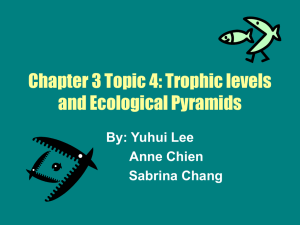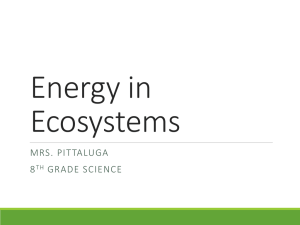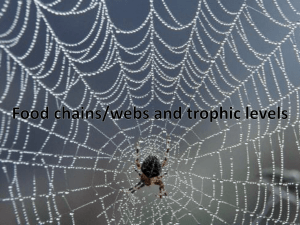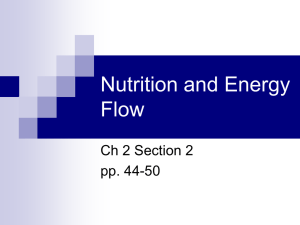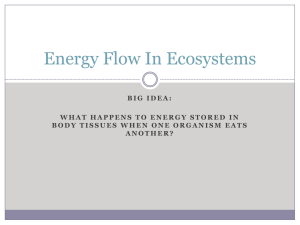Ecosystems Topic 4: Trophic Levels - Wikispaces
advertisement
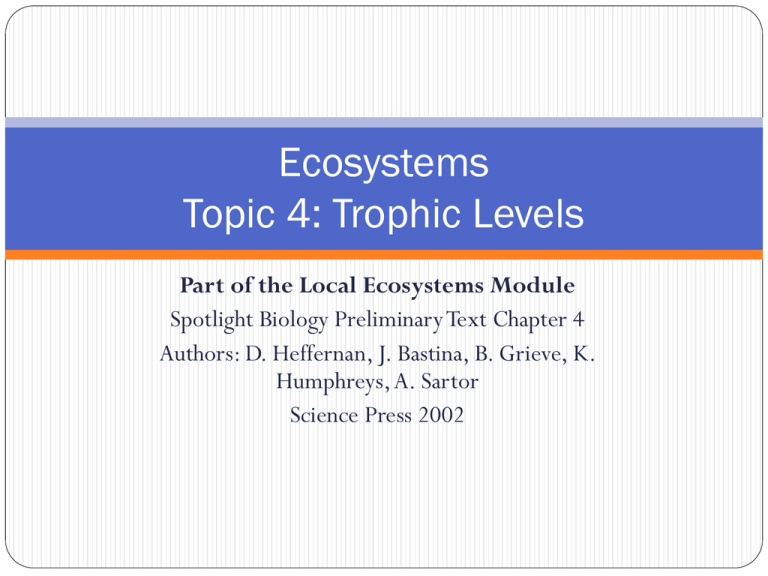
Ecosystems Topic 4: Trophic Levels Part of the Local Ecosystems Module Spotlight Biology Preliminary Text Chapter 4 Authors: D. Heffernan, J. Bastina, B. Grieve, K. Humphreys, A. Sartor Science Press 2002 Trophic Levels Understanding the movement of energy through living systems is essential to understanding ecology. Beginning with the capture of sunlight by primary producers, energy passes through food chains and webs from producer to consumer. As it flows, energy is alternately stored and used to allow life processes of all organisms to continue. Trophic Levels The biomass of an ecosystem is the mass of living material in an area. This can be expressed in units of either energy (𝑘𝐽𝑚−2 ) or dry organic matter (𝑘𝑔𝑚−2 ) Trophic Levels A better measure of the energy produced in an ecosystem is the rate at which new biomass is produced per unit area. This is known as the net primary productivity of a community and is measured in wither unites of energy or mass of dry organic matter per unit area per unit of time. Community Primary Productivity (𝑘𝑔𝑚−2 𝒚𝒓−𝟏) Biomass (𝑘𝑔𝑚−2 ) Tropical Rainforest 2.0 44.0 Open Forest 1.3 36.0 Woodland and shrubland 0.6 6.8 Temperate grassland 0.5 1.6 Desert 0.07 0.67 Open Ocean 0.1 1.0 Continental Shelf 0.4 0.01 Lake and stream 0.5 0.02 Trophic Levels The energy captured by producers and consumers is temporarily stored until one organism eats another. Each of these storage steps along a food chain or web is called a trophic level. Primary producers represent the first trophic level, herbivores occupy the second and carnivores the third. Trophic Level Producers and Consumers Autotrophs and heterotrophs Herbivores and Carnivores First Primary Producer Autotroph Second Primary consumer Heterotroph Herbivore Third Secondary consumer Heterotroph Carnivore 1 Fourth Tertiary consumer Heterotroph Carnivore 2 Trophic Levels In theory there is no limit to the number of trophic levels but in reality there is practical limitations. Every time one organism eats another, only a small fraction of the energy present in the lower trophic level is stored and used in the next higher level. emc.maricopa.edu Efficiency The percentage of energy transferred from one trophic level to the next is known as the ecological efficiency. The values are typically low, often between 5% and 20%. scienceclarified.com Efficiency This means that not all of the net primary productivity of a trophic level is consumed by the next, and that not all of the energy consumed is converted into body mass. A lot is used during metabolism. Metabolism refers to the chemical processes that go on continuously inside the body to allow life and normal functioning. stephsnature.com Efficiency On average only about 10% of the energy fixed by plants is ultimately stored by herbivores. Only 10% of the energy herbivores accumulate ends up being stored in the living tissues of the carnivores that eat them. And only about 10% of that energy is successfully converted into living tissue by carnivores in the third trophic level. buildaroo.com Food Pyramids The fact that only 10% is used at each trophic level is important because the less energy available at any trophic level, the less living tissue that trophic levels can support. europeanraptors.org Food Pyramids Inefficient energy chains thus create what we call ecological pyramids. In an ecological energy period, each trophic level contains only 1/10 as much energy in living tissue as the layer beneath it. If biomass is used to construct the pyramid, it is called an ecological biomass pyramid. stephsnature.com Food Pyramids This relationship also produces a pyramid of numbers, which means that each successive trophic level also contains fewer individual organisms than the one below it. stephsnature.com Food Pyramids In some cases the consumers are much smaller than the organism the consume so the pyramid numbers are turned upside down. For example, countless numbers of mosquitoes may feed off a one or a few animals. The pyramid biomass still applies to this situation though. merkosoncampus.com Why Big Animals Eat Plants The ecological rules we’ve just talked about have dramatic social and ecological consequences. For example, if you choose to only eat red meat to gain 1 kilogram of weight, you need to eat 10 kilograms of beef. The cow that produced the 10 kilograms of flesh must have originally eaten at least 10 times that weight (100kg) of grass or feed. briankaneonline.com For us to obtain one unit of energy from beef required the storage of at least 100 units of energy in cattle feed. (this doesn’t include the energy spent to process, store, transport and sell the meat) Why Big Animals Eat Plants That’s why it make good ecological sense that the largest land animals are vegetarians and that the largest marine animals are plankton feeders. Such large animals need huge quantities of food to build their living tissue. mountainseer.blogspot. com Why Big Animals Eat Plants If they were to feed on large animals, those already on the 4th or 5th trophic levels, the total amount of primary production needed to support them would be enormous! A given ecosystem could support very few if any of them. By feeding at or near the base of the ecological pyramid, whales and elephants make much more efficient use of energy so that a given ecosystem can support many more of them. butterfunk.com Homework Students to complete the mid-topic quiz


